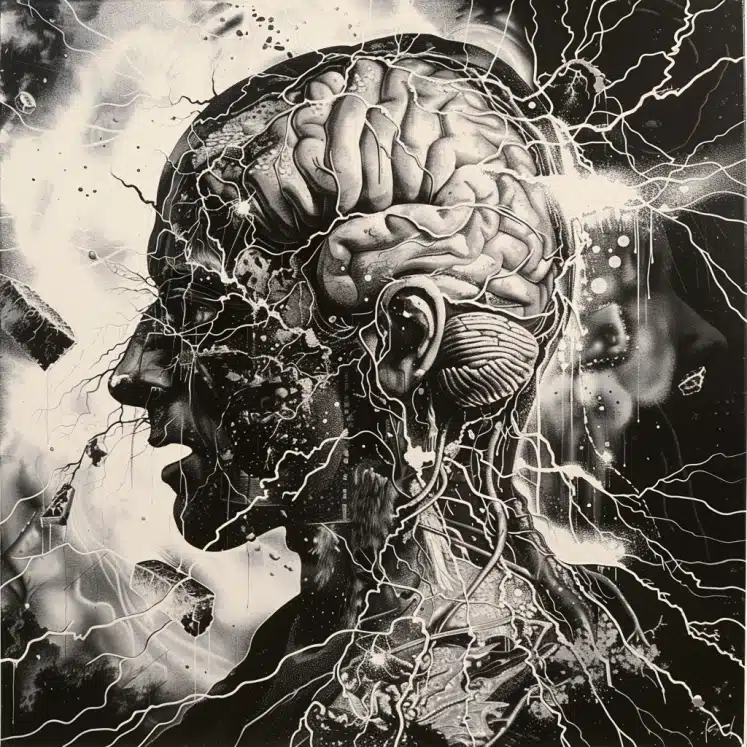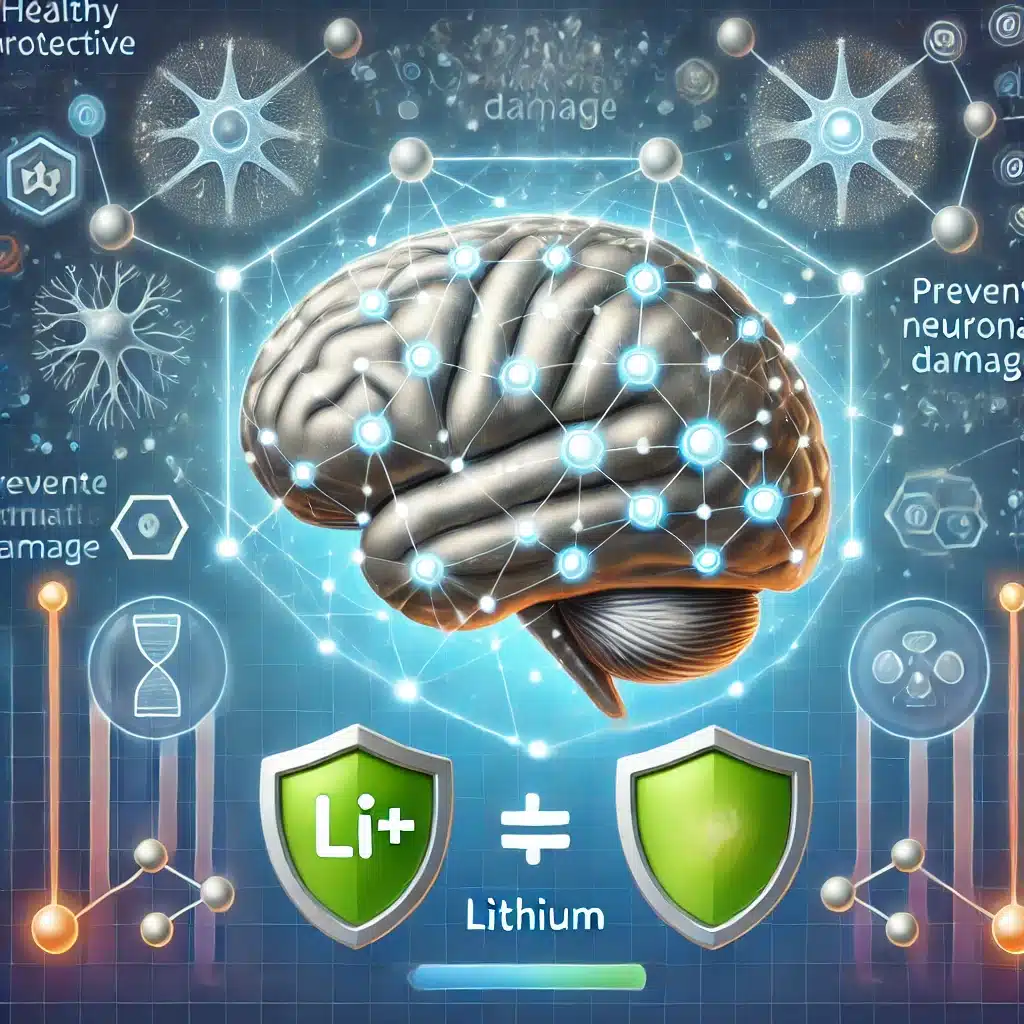Lithium shows promise in treating traumatic brain injury (TBI) by mitigating neuroinflammation, protecting against neuronal damage, and improving cognitive functions.
Highlights:
- Neuroprotective Mechanisms: Lithium’s therapeutic effects involve complex molecular mechanisms including gene expression, neurotransmitter signaling, and circadian modulation, contributing to neuronal protection and recovery post-TBI.
- Targeted Brain Regions: Post-treatment, lithium concentrations are notably higher in critical brain areas like the hippocampus, thalamus, and neo-cortex, which are vital for cognitive functions such as memory and learning.
- Reduction of Neuroinflammation: Lithium effectively reduces neuroinflammation and neuronal toxicity, which are significant contributors to TBI-induced cognitive decline, thereby promoting neuronal survival.
- Cognitive & Functional Improvements: Lithium administration post-TBI enhances memory, spatial learning, and overall cognitive functions by protecting the brain from edema, hippocampal neurodegeneration, and loss of brain tissues.
Source: Brain & Behavior (2024)
Key Findings: Lithium in Traumatic Brain Injury (TBI) Treatment
1. Neuroprotective Mechanisms
Lithium exhibits neuroprotective properties through a variety of complex molecular mechanisms. These include:
- Gene Expression & Signaling: Lithium influences gene expression and neurotransmitter signaling, which helps to regulate various cellular processes. By modifying these signals, lithium can reduce cell death and promote cell survival.
- Circadian Modulation: Lithium also affects circadian rhythms, which are the body’s natural processes that follow a 24-hour cycle. This regulation can improve overall brain function and recovery after TBI.
- Ion Transport: By modulating ion transport, lithium helps maintain the electrical balance in neurons, crucial for proper brain function and reducing excitotoxicity, a condition where nerve cells are damaged due to excessive stimulation by neurotransmitters.
2. Targeted Brain Regions
After lithium treatment, its concentrations are significantly higher in several key brain regions:
- Hippocampus: This area is essential for memory formation and learning. Higher lithium levels in the hippocampus help protect against damage and improve cognitive functions.
- Thalamus and Neo-Cortex: These regions are critical for sensory processing and higher-order brain functions. Lithium’s presence here aids in maintaining normal brain activities and preventing cognitive decline.
- Olfactory Bulb, Amygdala, and Cerebellum: These areas are involved in smell, emotional processing, and motor control, respectively. Enhanced lithium concentrations help in preserving their functions post-TBI.
3. Reduction of Neuroinflammation
Neuroinflammation is a significant cause of continued brain damage following TBI. Lithium helps to:
- Suppress Inflammatory Responses: Lithium reduces the activity of microglia and astrocytes, the brain’s primary immune cells, which are often overactive after TBI. This suppression helps to decrease the production of inflammatory molecules like cytokines and reactive oxygen species.
- Protect Neurons: By attenuating neuroinflammation, lithium protects neurons from further damage, promoting better survival rates and aiding in brain repair processes.
4. Cognitive & Functional Improvements
Lithium treatment leads to notable improvements in cognitive functions and overall brain health:
- Enhanced Memory and Learning: Lithium helps restore cognitive abilities such as memory and spatial learning, which are often impaired after TBI. This is achieved through its protective effects on the hippocampus and other cognitive centers.
- Prevention of Edema and Neurodegeneration: Lithium protects the brain from swelling (edema) and neurodegeneration, particularly in the hippocampus, thereby preserving brain structure and function.
- Reduced Tissue Loss: Lithium treatment reduces the loss of hemispheric tissues, which is critical for maintaining brain integrity and preventing long-term cognitive deficits.
5. Comprehensive Research Findings
Extensive research consolidates lithium’s multifaceted role in treating TBI:
- Normalization of Cortical Imbalance: TBI often leads to an imbalance in cortical excitation and inhibition, disrupting normal brain function. Lithium helps to restore this balance, promoting healthier brain activity.
- Support for Cognitive Recovery: By addressing the molecular and cellular damages caused by TBI, lithium provides a supportive environment for cognitive recovery and functional rehabilitation.
Report Overview: Lithium for TBI Treatment (2024)

The aim of this report was to explore how lithium can help treat traumatic brain injury (TBI) by understanding its molecular mechanisms and therapeutic effects on brain function and recovery.
Sample
The report reviewed existing research on both human and animal models that examined the effects of lithium treatment on TBI. This included various studies that looked at how lithium interacts with different brain regions and its overall impact on brain health.
Methods
- Data Collection: The researchers used “Boolean logic” to search for relevant articles on PubMed, PubMed Central, and Google Scholar. They focused on studies that discussed lithium and TBI, especially those involving brain regions, neurotransmission, neuroinflammation, and signaling pathways.
- Inclusion Criteria: Only studies that reported or discussed the relationship between lithium and TBI mechanisms were included.
- Analysis: The collected studies were critically reviewed to summarize the molecular mechanisms and therapeutic effects of lithium on TBI.
Limitations
- Varied Study Designs: The reviewed studies had different designs, which can make it challenging to compare results directly.
- Limited Human Studies: While many studies used animal models, there were fewer human studies, which limits the ability to generalize findings to all people with TBI.
- Potential Bias: The selection of studies based on specific search terms might have excluded relevant research, introducing potential bias.
Comparison of Lithium to Other Agents Used for TBI Treatment

Common Agents for TBI Treatment
Several agents are commonly used to manage traumatic brain injury (TBI), including:
- Corticosteroids: Used to reduce inflammation and brain swelling.
- Anti-seizure Medications: Prevent seizures that can occur after TBI.
- Neuroprotective Agents: Various drugs aimed at protecting brain cells from damage.
- Antioxidants: Reduce oxidative stress and damage in brain tissue.
- Hyperosmolar Agents: Decrease intracranial pressure by drawing fluid out of the brain.
Lithium vs. Other Agents
Lithium
- Neuroprotective Effects: Lithium protects neurons by reducing neuroinflammation and preventing neuronal cell death.
- Gene Expression Modulation: Alters gene expression and neurotransmitter signaling, promoting cell survival.
- Balancing Cortical Excitation and Inhibition: Restores balance in brain circuits disrupted by TBI.
- Neurotransmitter Regulation: Modulates glutamate and GABA levels, reducing excitotoxicity and supporting neurotransmission.
- Reduction of Edema: Helps prevent brain swelling and protects against loss of brain tissues.
Corticosteroids
- Anti-inflammatory: Reduce inflammation and immune response.
- Risk of Side Effects: Can cause significant side effects like increased infection risk and hyperglycemia.
- Anti-seizure Medications
- Seizure Prevention: Control electrical activity in the brain to prevent seizures.
- Limited to Seizures: Primarily focused on preventing seizures rather than overall brain recovery.
Neuroprotective Agents
- Various Mechanisms: Includes drugs like NMDA receptor antagonists and calcium channel blockers to protect neurons.
- Mixed Efficacy: Variable results in effectiveness across different studies.
Antioxidants
- Oxidative Stress Reduction: Neutralize free radicals and reduce oxidative damage.
- Supportive Role: Often used as supplementary therapy rather than primary treatment.
Hyperosmolar Agents
- Pressure Reduction: Lower intracranial pressure by osmotically drawing out excess fluid.
- Short-term Use: Typically used in acute settings rather than long-term treatment.
How Lithium Ranks
- Efficacy: Lithium demonstrates significant neuroprotective and cognitive benefits, making it a strong candidate for TBI treatment.
- Mechanism Versatility: Its ability to modulate neurotransmission, reduce neuroinflammation, and protect against edema and cell death gives it a comprehensive approach to treating TBI.
- Research Support: Supported by a variety of studies showing its beneficial effects on different brain regions and overall brain health.
- Comparison: Compared to other agents, lithium offers a broader range of protective mechanisms and long-term benefits. However, it must be considered carefully due to its side effects and the need for monitoring serum levels.
Conclusion: Considering Lithium to Treat TBI-Related Damage
This study highlights lithium’s potential as a powerful therapeutic agent for traumatic brain injury (TBI).
Through various mechanisms, including modulation of gene expression, neurotransmitter signaling, and reduction of neuroinflammation, lithium offers comprehensive neuroprotective effects.
Its ability to target key brain regions and improve cognitive functions such as memory and learning makes it a promising treatment option.
Compared to other commonly used agents, lithium’s multifaceted approach provides significant advantages in promoting brain health and recovery post-TBI.
However, the need for careful monitoring and management of side effects is crucial to its clinical application. Further research and clinical trials are necessary to fully establish its efficacy and optimize its use in TBI treatment.
References
- Study: Elucidating the pivotal molecular mechanisms, therapeutic and neuroprotective effects of lithium in traumatic brain injury (2024)
- Author: Seidu A Richard







